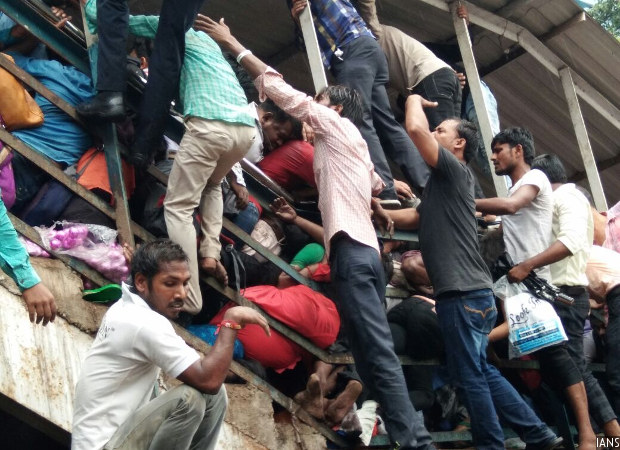Mumbai Locals: World’s Busiest Urban Rail System Is Also Its Deadliest
The stampede on the bridge at Elphinstone Road suburban railway station in Mumbai killed 22 passengers and injured several others. Mumbai’s local trains carry about 7.5 million passengers every day, packed, on average, to 2.6 times their capacity.
The death of 22 in a stampede on a bridge on September 29, 2017, propelled the pressures on the Mumbai’s local trains to headline news, but at least nine commuters die (as IndiaSpend has previously reported) every day on the world’s busiest--and deadliest--urban railway.
In 65 years, the passenger load on Mumbai’s suburban rail system grew more than eight times, while train capacity grew about three times, revealing how the city’s commuter-rail infrastructure has failed its commuters, according to railway data and IndiaSpend extrapolations from those data.
Mumbai’s local trains carry about 7.5 million passengers every day, packed, on average, to 2.6 times their capacity. In contrast, rail coaches on the Tokyo metro, a system known for overcrowding, carry double their capacity.
In 1952, Mumbai’s suburban rail system was carrying 292 million passengers; by 2016 that number was up to 2.7 billion, or, as we said, about eight times higher. Over the same period, the number of trains grew about three times--from 741 to 2,800.
Source: 1951-52 to 2004-05: Indian Railway Statistical Manual; For 2016, the estimate has been arrived at considering an average load of 7.5 million passengers a day.
Such pressures on the commuter-rail system strain platforms, bridges--such as the one at Elphinstone Road where the stampede occurred--and other infrastructure as they struggle to cater to many times more commuters than they were designed for.
As a consequence, commuters in Mumbai routinely fall out of trains or die crossing the tracks. In 10 years to 2015, 6,989 died after falling from trains and 22,289 died crossing the tracks, as the Indian Express reported on September 13, 2015.
22 dead, several injured in #Elphinstonestampede in Mumbai. This thread tells us the world’s busiest network is also its deadliest: 1/n
— IndiaSpend (@IndiaSpend) September 29, 2017
In 10yrs to 2015, 6,989 died after falling from Mumbai trains, 22,289 died crossing tracks: #Elphinstonestampede https://t.co/JgTMHsR6ji 2/n
— IndiaSpend (@IndiaSpend) September 29, 2017
B/w Jan 2016-Jul 2017, 3,380 deaths in Mumbai trains. Major causes: falling off crammed coach: 981; run over at line crossing: 1,126 (3/n)
— IndiaSpend (@IndiaSpend) September 29, 2017
Since 2012, 19,160 killed in Mumbai local train accidents: Railway police data #Elphinstonestampede 4/n pic.twitter.com/WSVmlNNhxS
— IndiaSpend (@IndiaSpend) September 29, 2017
Top 3 line-crossing-death sites b/w Jan 2016-Jul 2017: Kurla-Vidyavihar (45), Andheri (33), Masjid-Sandhurst Road (27) 5/n
— IndiaSpend (@IndiaSpend) September 29, 2017
B/w Jan-Jul 2017, most people killed by falling off overcrowded compartments on Andheri-Vile Parle stretch (28) 6/n
— IndiaSpend (@IndiaSpend) September 29, 2017
8 mn passengers--more than popn. of Hyderabad--travel on Mumbai rail network every weekday on 2,800 services: https://t.co/JuE84ArBDQ 7/n
— IndiaSpend (@IndiaSpend) September 29, 2017
In 65 yrs, 8.3x rise in passengers travelling on Mumbai locals, 2.8x rise in number of trains #Elphinstonestampede 8/n pic.twitter.com/W79Y8m8hN0
— IndiaSpend (@IndiaSpend) September 29, 2017
More than 2.2 mn travel in peak direction on Mumbai locals b/w 7am & 11.30am or b/w 4pm & 8.30pm. #Elphinstonestampede 9/n
— IndiaSpend (@IndiaSpend) September 29, 2017
Morning peak hour for Mumbai locals: 8.30-9.30am with 632,000 travelling. Evening peak hour: 6-7pm with 587,000 #Elphinstonestampede 10/n
— IndiaSpend (@IndiaSpend) September 29, 2017
Over 4,500 passengers packed in a 9-car Mumbai local train during peak hours. Capacity: 1,700 #Elphinstonestampede 11/n
— IndiaSpend (@IndiaSpend) September 29, 2017
Mumbai’s suburban trains, on avg, more than 4 minutes apart, contributing to overcrowding #Elphinstonestampedehttps://t.co/t3lKQr2Uwj 12/n
— IndiaSpend (@IndiaSpend) September 29, 2017
Fewer handles on Harbour line than Central, Western lines; no handles b/w seats causing overcrowding near doors: TISS 2016 survey 13/n
— IndiaSpend (@IndiaSpend) September 29, 2017
"Slippery rod at coach doors causes accidents," complain women commuters: TISS 2016 survey https://t.co/UpuYMpG5S9 14/n
— IndiaSpend (@IndiaSpend) September 29, 2017
65% of 1,000 respondents complained about platform height in TISS 2016 survey #Elphinstonestampedehttps://t.co/UpuYMpG5S9 15/15
— IndiaSpend (@IndiaSpend) September 29, 2017
Seoul's is longer (940 km), New York's has more stns (468), but Mumbai's local trains carry most passengers (7.6 mn) over 460 km/ 130 stns
— IndiaSpend (@IndiaSpend) September 29, 2017
Mumbai trains run at 2.6x capacity, world's most crowded; bridges, platforms under pressure. https://t.co/vigzPQqRP9 #elphinstonestampede
— IndiaSpend (@IndiaSpend) September 29, 2017
Mumbai's suburban system, India's most overcrowded, carries 14-16 passengers per sq m of floor space https://t.co/vigzPQqRP9 #elphinstone
— IndiaSpend (@IndiaSpend) September 29, 2017
Tokyo's overcrowded metro coaches run 2x overcapacity, Mumbai's at 2.6x overcapacity, world's most pressured system. #elphinstonestampede
— IndiaSpend (@IndiaSpend) September 29, 2017
We welcome feedback. Please write to respond@indiaspend.org. We reserve the right to edit responses for language and grammar.
__________________________________________________________________
“Liked this story? Indiaspend.org is a non-profit, and we depend on readers like you to drive our public-interest journalism efforts. Donate Rs 500; Rs 1,000, Rs 2,000.”



